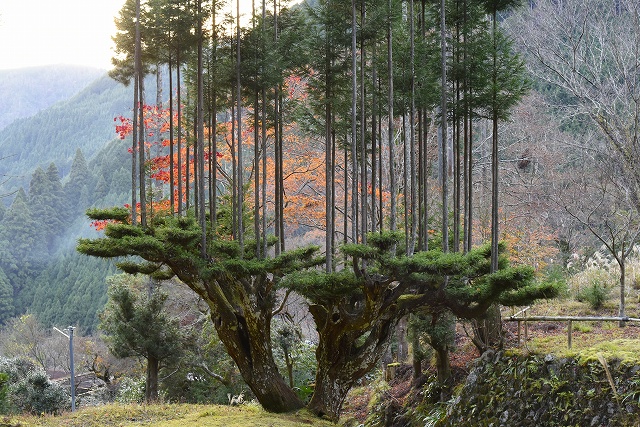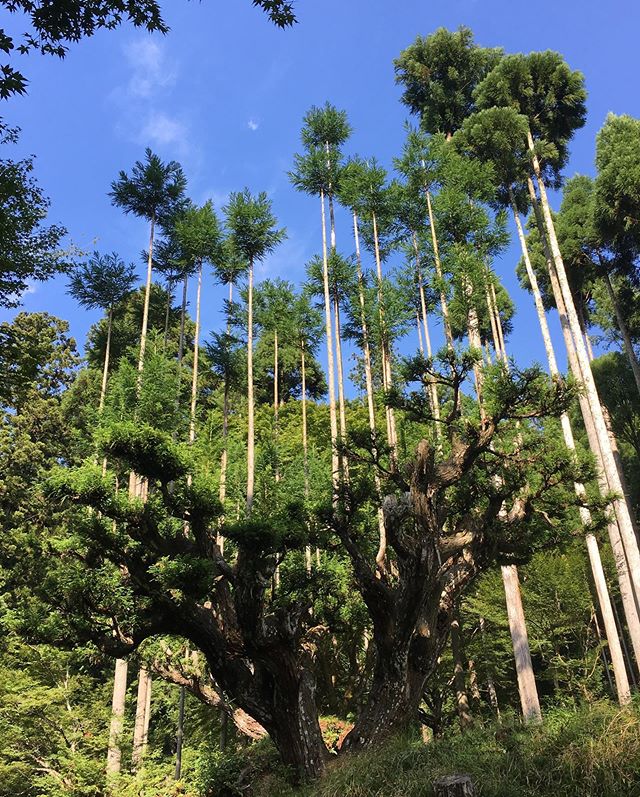
We’ve all admired the elegance of Japan’s traditional styles of architecture. Their development required the kind of dedicated craftsmanship that takes generations to cultivate — but also, more practically speaking, no small amount of wood. By the 15th century, Japan already faced a shortage of seedlings, as well as land on which to properly cultivate the trees in the first place. Necessity being the mother of invention, this led to the creation of an ingenious solution: daisugi, the growing of additional trees, in effect, out of existing trees — creating, in other words, a kind of giant bonsai.
“Written as 台杉 and literally meaning platform cedar, the technique resulted in a tree that resembled an open palm with multiple trees growing out if it, perfectly vertical,” writes Spoon and Tamago’s Johnny Waldman. “Done right, the technique can prevent deforestation and result in perfectly round and straight timber known as taruki, which are used in the roofs of Japanese teahouses.”
These teahouses are still prominent in Kyoto, a city still known for its traditional cultural heritage, and not coincidentally where daisugi first developed. “It’s said that it was Kyoto’s preeminent tea master, Sen-no-rikyu, who demanded perfection in the Kitayama cedar during the 16th century,” writes My Modern Met’s Jessica Stewart.

At the time “a form of very straight and stylized sukiya-zukuri architecture was high fashion, but there simply weren’t nearly enough raw materials to build these homes for every noble or samurai who wanted one,” says a thread by Twitter account Wrath of Gnon, which includes these and other photos of daisugi in action. “Hence this clever solution of using bonsai techniques on trees.” Aesthetics aside — as far aside as they ever get in Japan, at any rate — “the lumber produced in this method is 140% as flexible as standard cedar and 200% as dense/strong,” making it “absolutely perfect for rafters and roof timber.” And not only is daisugi’s product straight, slender, and typhoon-resistant, it’s marveled at around the world 600 years later. Of how many forestry techniques can we say the same?
Related Content:
The Art & Philosophy of Bonsai
Based in Seoul, Colin Marshall writes and broadcasts on cities, language, and culture. His projects include the Substack newsletter Books on Cities, the book The Stateless City: a Walk through 21st-Century Los Angeles and the video series The City in Cinema. Follow him on Twitter at @colinmarshall, on Facebook, or on Instagram.


Interesting take but I’m not buying.
Yes trees can be pruned to affect future growth, but not to change their genetic dispositions to be tall or straight or whatever. You can keep pruning for some ongoing desired effect, as I suspect the trees in these pics have been to remove all branches up to the highest level of the canopy. I suppose that could help in ensuring a smooth and straight trunk. But calling something a “giant bonsai” is a puzzler. Isn’t that another word for “tree”?
Also it seemed odd to try to grow trees this tall on the weak support of branches as seen in the top picture. Comparing the two pics made me think all the more we’re being fed some guff. Look at the trunks in the two pics to see what I mean.
Anyway, just some random first impressions with zero research so if I’m wrong, sorry. I hope the writer continues to find and report on interesting international tree news — always a worthy topic.
It does seem a little bit too perfect, why would the trees grow straight just because they are on other trees?
This require a lot of work. You need to carefully prune them every two years (so you can remove all the knots in the wood) for twenty years.
Here’s your giant bonsai
Also known as ‘coppicing’ in the West, a common practise … it’s not that unusual!
As Ivo says this is a standard woodland management technique, called coppicing in the west, which has been practiced for hundreds of years to do exactly this — produce straight usable pole size timber which can be harvested over and over again, on a 5 — 15 year rotation time scale, without having to fell the original tree from which the ‘poles’ grow.
In my experience its practiced on broadleaf species including commonly hazel, alder, willow, chestnut, ash, and sometimes oak.
It’s fallen out of wide scale use sadly with the rise of destructive industrial scale commercial forestry, but is re-emerging as a good sustainable way of managing woodland.
I’ve never seen it done on a conifer and it looks fascinating.
There’s no magic to ‘buy’! or anything too ‘perfect’ about it — its just what nature does! And its got nothing to do with altering the trees genetics!
Prune an apple tree and see what happens — it throws up water shoots — exactly the same reaction by the tree.
This is great technique . The technique shuuld be impliments in India. Thise type of knowledge should be addded in our school and college syllabus and should implement on it . I am trying my best to implement this technique in my nation INDIA 💯💯
Your comment tells me that you know little about the history of Japan and their well known competition with nature. If you have seen any Bonsai, that is the work of the Japanese. I have been to commercial orchards and often go for the harvest, a have picked an apple weighing 700gramms and had peaches just short of 1kg
Please do more research
https://www.openculture.com/2020/10/daisugi.html
Considering that 67% of Japan’s land surface is even today covered by forests and plantations, and given that Hinoki, Sugi and red pine naturally tend to grow straight and tall, there is no need for daisugi. Not only is it unnecessarily time consuming when there are MILLIONS of normally growing trees available, but it will not produce nearly enough timber. I lived in rural Japan and close to my village there were virtually impenetrable hinoki forests used by two sawmills in the village, sawmills that had been in operation for many generations.
As for the notion that the Japanese are “in competition with Nature”, that’s an idea inimical to the Japanese: they live in HARMONY with nature, not in competition with it.
You’re an idiot
In Australia the Indigenous semi- nomadic people grew trees in other trees in semi- arid zones — strange but true. Google scartrees. com .au & go to the Trees in Trees archive